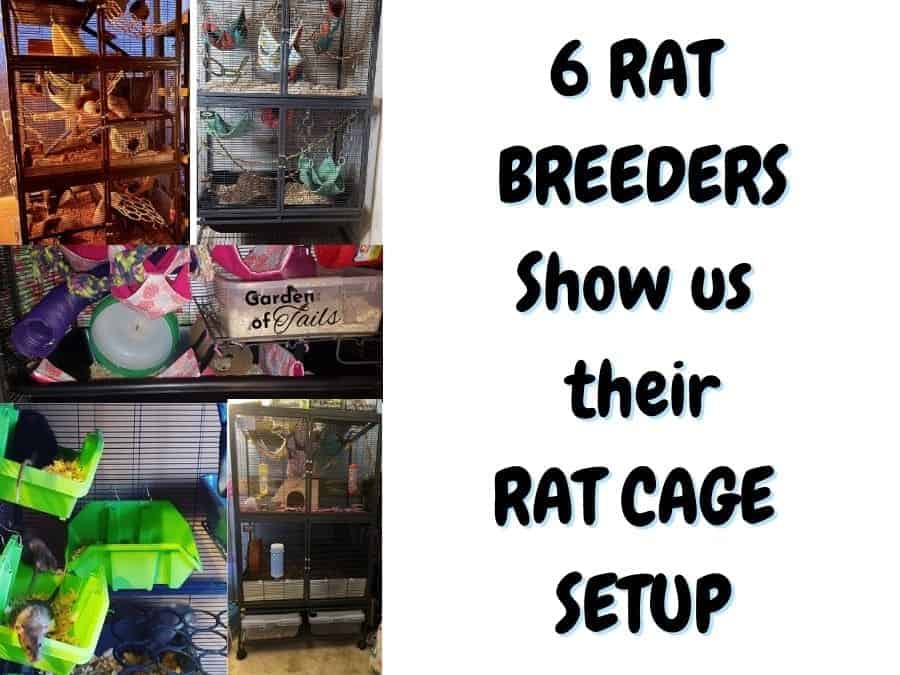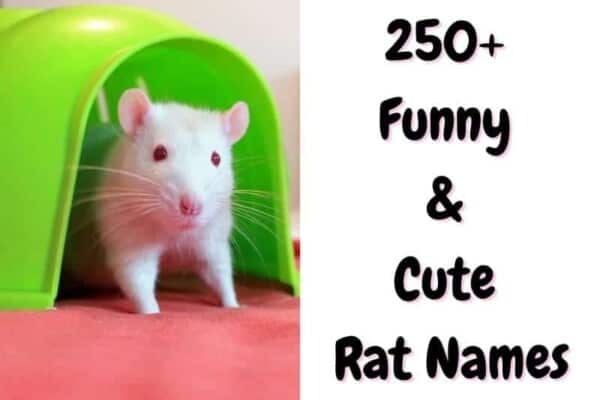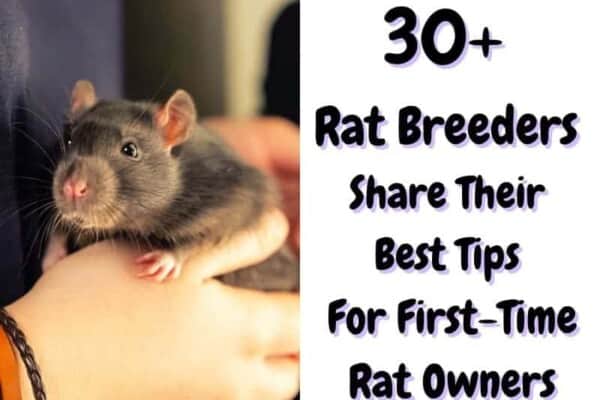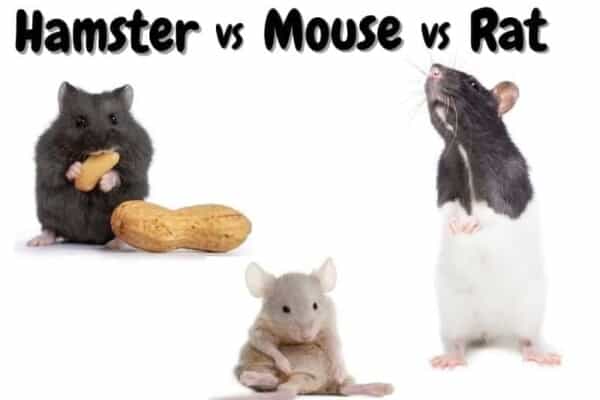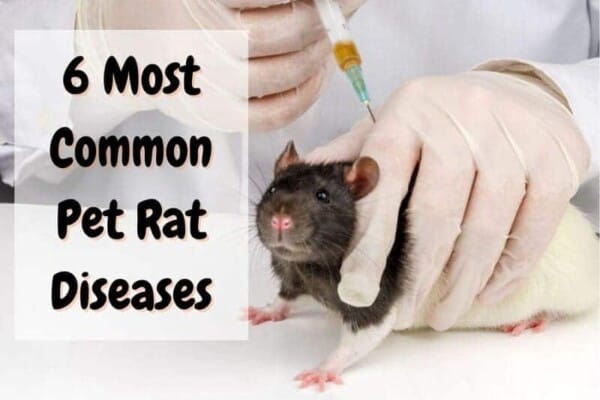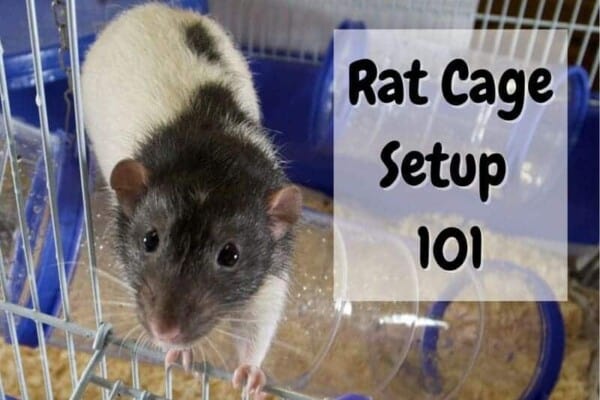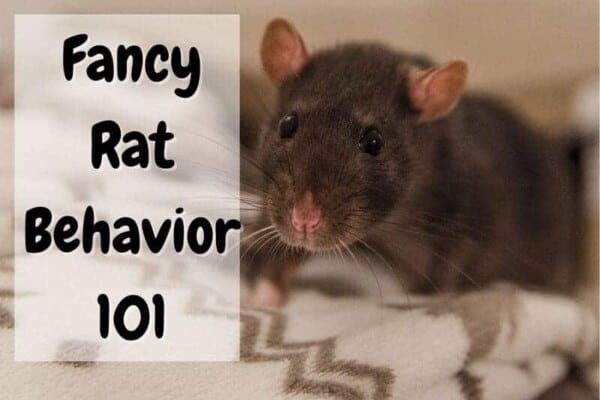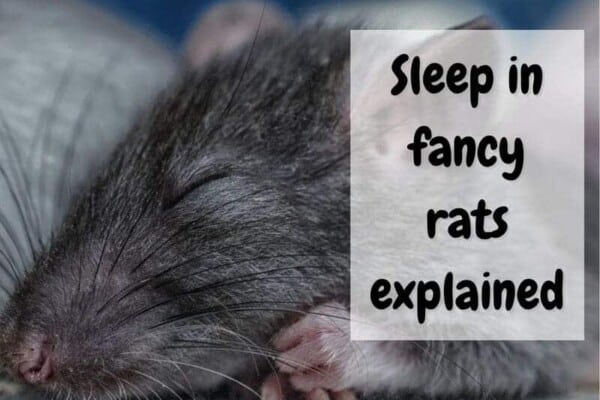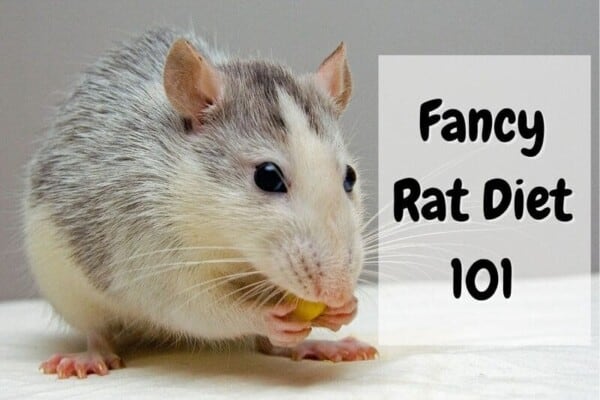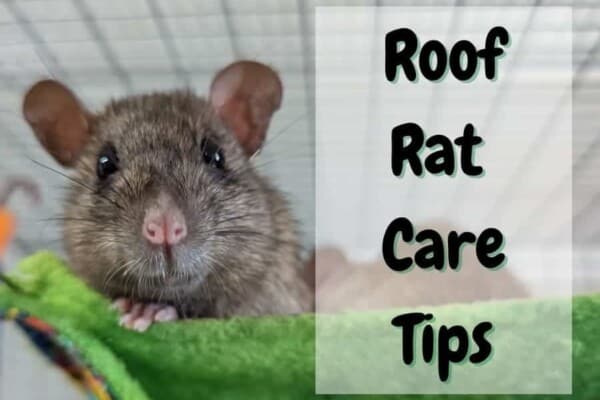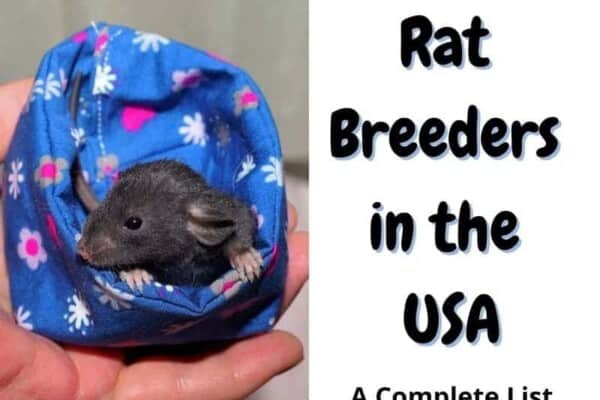We’ve all been there – scratching our heads trying to figure out the best rat cage setup possible to make sure our little mischief lives a happy life from day one.
How do you know that you are setting up your rat cage the right way, though? This is a question many rat lovers ask us all the time. So we’ve decided to contact several rat breeders across the continent to ask them how THEY are setting up their rat cages.
You will learn today not only what cage they are using but also the kind of toys, bedding, and other enrichment they are adding to their cage to make it a really pleasant home for their rodents.
A big thank you to the 6 selected breeders and all who brought their contributions to this post. Feel free to contact them on their Facebook page or website to know more about their amazing work. Our hope is that it will help you set up the perfect environment for your little ratties!
Ginger, Garden of Tails – Alexandria, IN

Rats are fossorial by nature, so having a cage that is wide enough to provide ground space is just as important as a cage that includes height. Many new adopters come to me with links to cages that are tall rather than wide. Having a healthy mix of both provides the proper enrichment needs for rats.

One of the most popular brands is the Critter Nation cage. A single Critter Nation can fit up to 6 rats if the space is used well. I will go into further detail on how the space can be utilized the best shortly. A double Critter Nation cage can fit up to 12 rats if the space is used well. Most pet adopters don’t typically have larger numbers, but some do enjoy a bigger colony of cuties.
Utilizing cage space well means filling the empty spaces with various forms of enrichment items such as baskets, perches, hammocks, hides, chew toys, foraging bins, litter boxes, etc. Whether you have a pair of rats or a bigger colony, keeping the cage full allows them to have options on where they want to sleep, eat, drink, use the bathroom, and play. I find it easiest to attach items to the cage with pipe cleaners. These can be cut to various sizes, which make for easy use. They’re also reusable!

The bars on the cage should be no more than 1/2 inch apart, or else a young rat may be able to squeeze through the bars and harm itself in the process. If the main cage you are looking to get has bigger bar spaces other than 1/2 inch, you can house your rats in your isolation cage temporarily until they are big enough to be placed in their main cage. Do not buy a small cage and later buy a bigger one when they grow up. Rats grow at an extremely quick rate, and they will be big enough to fit in a larger cage within a month, so it is not worth it to “wait until they’re bigger” before you get a big cage.
Below I will list some suitable as well as not suitable items.
Suitable Bedding:
- Aspen shavings (dust-free)
- Kiln-dried pine shavings (dust-free)
- Fleece (must be paired with litter training)
- Rabbit pellets
- Paper-based bedding (non-scented, non-dyed)
- Poplar Shavings
- Pine Equine Pellets
Not Suitable Bedding:
- Clay-based bedding
- Dusty bedding/shavings
- Scented or dyed bedding (paper, etc.)
- Non-kiln dried pine products
Suitable Enrichment:
- Hammocks (home-made, store-bought, and I also have an Etsy shop – if adopting let me know before so you can pick them up instead of having them shipped)
- Hides (Kaytee Igloo (large), space pod (large), tree trunk, wood arch, Lixit hide, Pigloo (large), barn hide, or cardboard boxes)
- Baskets (plastic baskets tend to last longest but woven ones work too – plastic baskets can be found at Dollar Tree)
- Lava Ledges (double as a chew and a ledge to sit/climb on)
- Chew toys (most wooden bird toys work well for rats – feel free to ask about certain ones if you’re not sure)
- Foraging boxes (fill with packing paper, scrap fabric, pom poms, paper bedding, add a few treats, toilet paper/cardboard scraps)
- Wheel (rats need a 12″ wheel or larger)
Not Suitable Enrichment:
- Wooden ledges/hides (these get dirty quickly and are near impossible to clean, building up ammonia)
- Fibrous material (stringy material like yarn, thread, stuffing, or nesting fluff can get caught around toes, limbs, or caught in their mouth causing injury or even death)
- Edible houses/logs (Snak Shak, Edible Logz, etc.) These are harmful when ingested due to the materials, not all being edible. They try to consume it all since they’re covered in honey)
- Hamster/mouse houses/supplies (a lot of times, I see people buying small houses/hammocks/etc. meant more for hamsters and mice. These items just don’t fit ratties, which will either end up wasted or they could get stuck in them)
- Harmful Wheels (mesh wheels can be harmful not from the mesh itself, but they are typically held by metal bars that I’ve seen animals get caught on.
- Exercise Balls: these are harmful to all animals. Their limbs can easily get caught in the slits as they walk/run in them, they provide little airflow/ventilation, and most rodents have poor eyesight, relying more on touch and smell. Being in a ball severely limits these senses, causing them to panic and continuously run to try to find a way out. This causes unnecessary stress and a likely chance of physical harm.
Say Hi to Ginger here:
- Website: https://www.facebook.com/groups/1942974535980529/about/
- Facebook: http://www.gardenoftails.com/
Crystal Smith, Morningstar Rattery – Farmer City, IL

One of the biggest things to remember is ROOM. They need the most room you can give them. I use Double Critter Nation cages. This is perfect for any age and helps prevent escapes. It’s highly easy to clean and provides a lot of options for customizing. While my girls are in their new DblCN, I am still making it as I want it. But, they are loving everything in it. This cage also provides storage under it as well as a place to house other things, like my spiders!
I like to have their living space on top. This means food, water, houses, hammocks, and blankets for them to cuddle in. I use 3-6 water bottles depending on how many I have in there at the time. Currently, I have 15 adults and juveniles. They have plenty of room to run, play, cuddle and wrestle around.

On the bottle level, we have a metal pan with kick guards to keep bedding in. I ordered this pan and guards from Bass Equipment Company. They also make one for the upper level with a cut-out. They are well made, provide protection from kicked bedding, and make it even easier to keep clean. Also, there’s a running wheel, a shelf with a blanket, and toys here. This is the fun level.
As you can see, my girls are super excited anytime someone opens their cage. This indicates a happy, healthy rat. Cleaning the cage at least once a week if using bedding, or 2-3 times a week if using linens will help keep them happy and healthy.
Say Hi to Crystal here:
- Instagram: https://www.instagram.com/MorningstarRattery/
- Facebook: https://m.facebook.com/MorningstarRattery2021
Read also: 30+ Rat Breeders Share Their Best Tips For First-Time Rat Owners
Laiza, Trash Rats Rattery – Bridgeport, CT
Here we have our boys’ setup. As you can see they have many places to sleep and hide. This helps them feel safe and secure. We purchased these baskets at the dollar tree. It really has many options for hides and entertainment.
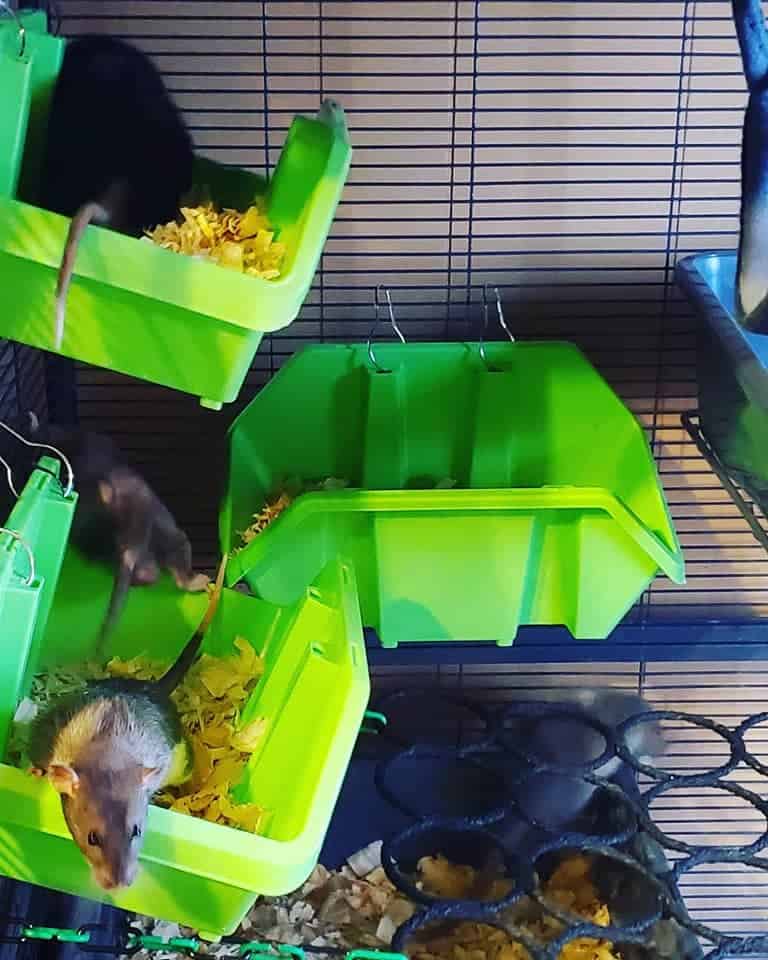
Rats need stimulation and enrichment toys to stay happy and healthy. I mean would you want to be stuck somewhere that has no fun activities? I don’t think you would and rats also don’t want that. So please make sure to have your ratties in an environment suitable and entertaining.
Here is the girls’ setup. Same idea: lots of hiding places and plenty of entertainment. We love Halloween so that is our year-long theme. They enjoy being bundled up together in their hides. We personally like to make our own hammocks.
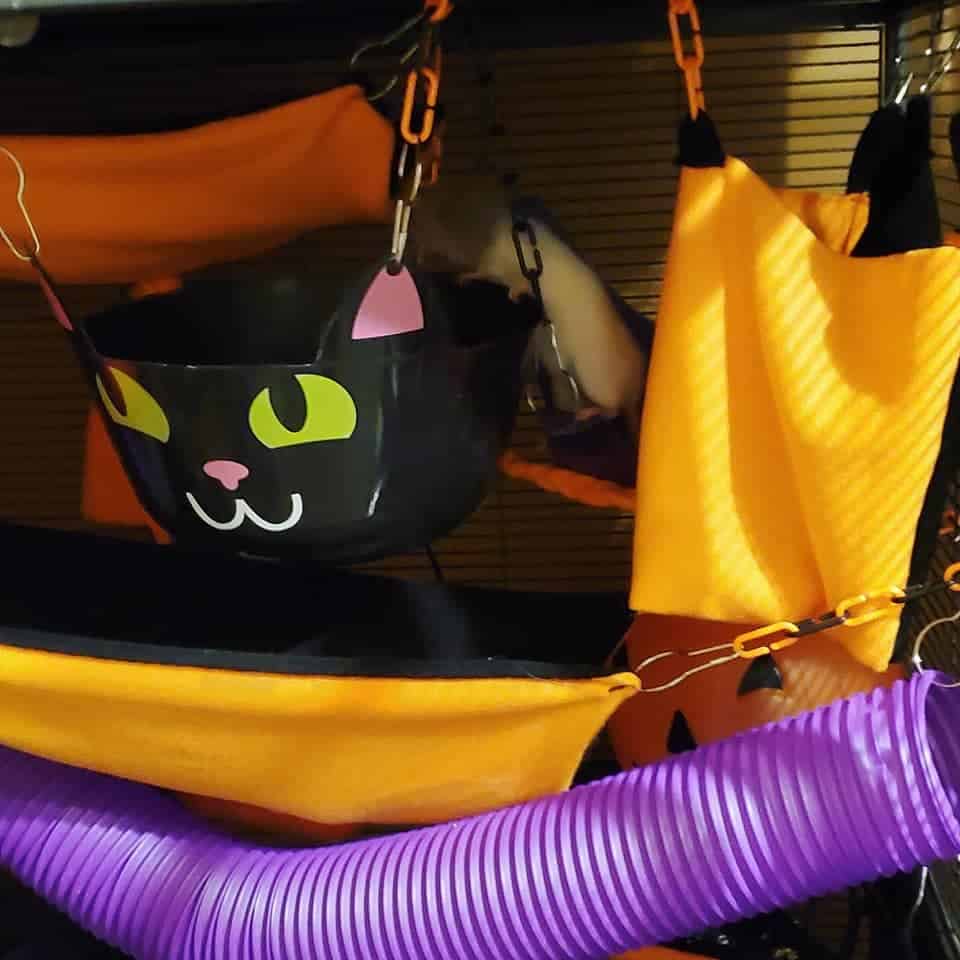
I find great joy in creating a safe hammock for them if you like crafts this will be a great option for you. I would switch the shower curtain rings to C hooks. The tunnel is called Niteangel small animal tunnel – I recommend cleaning it often.
We like to use glass water bottles in case of chewers. We recommend Lixit chew-proof flat back glass bottle for rabbits. We also recommend always checking bottles to make sure that water is accessible so we tap on the tip to make sure the water flow is correctly working.
Also, enrichment toys are a must. Here are a few we recommend. Bird creative foraging system wheel and OFLAO Bird Foraging Toys
Keeping your rats’ teeth is important. You can help them with good wood chews. You should have a few rat-safe chews in their cage as well as something to help with their nails. We recommend Lava ledges that can help them and add more entertainment.
Lastly, we recommend an outside area safe for your ratties. We personally recommend a playpen area that is set up correctly and you must keep watch. This item is called Songmics playpen. We purchased two to stack on top of one another so no one jumps and escapes.
Also for bedding, we recommend kiln-dried pine bedding or kiln-dried aspen. This is safe to use and we find it easier to clean. We do not recommend fleece solely as bedding. We see and know of many cases where rats tend to get Uri infections. You should be cleaning out your cages at least once a week or twice depending on how many rats you have.
This also brings me to the size of cages. We prefer Critter Nations as it’s chew-proof and has a good amount of space depending on your mischief size. Also, bar spacing should be 1/2. This prevents any escapes, especially baby ratties.
We also always have hospital cages set aside in case of emergencies and surgeries that might occur. Hospital cages should be simple, with no climbing as we do not want them to injure themselves after surgery and such. We prefer bin cages because it’s cheap and affordable. You can find great videos on youtube on how to make a bin cage.
Say Hi to Laiza here:
- Facebook: https://www.facebook.com/TrashRatsRattery/
- Instagram: https://www.instagram.com/trashratsrattery/
- Website: https://trashratsrattery.weebly.com/
Rachel, Little Heroes Rattery – Orlando, FL
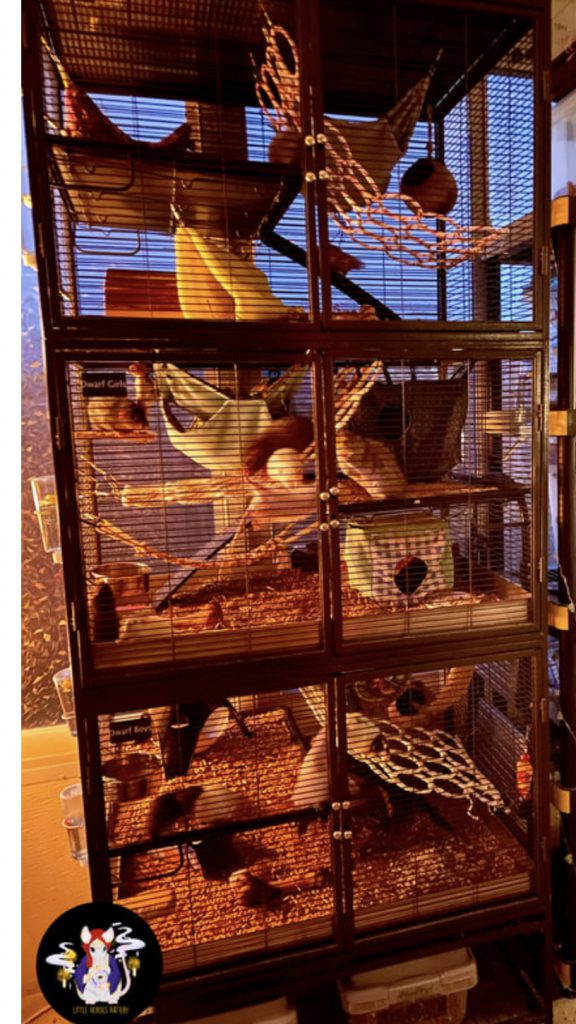
Housing is one of the most important aspects of pet guardianship. You would not buy a fish before getting a tank, and you would not adopt a dog or cat if you didn’t have a home to bring them to. Rats are no different, and unfortunately, big-box pet stores do not have suitable options.
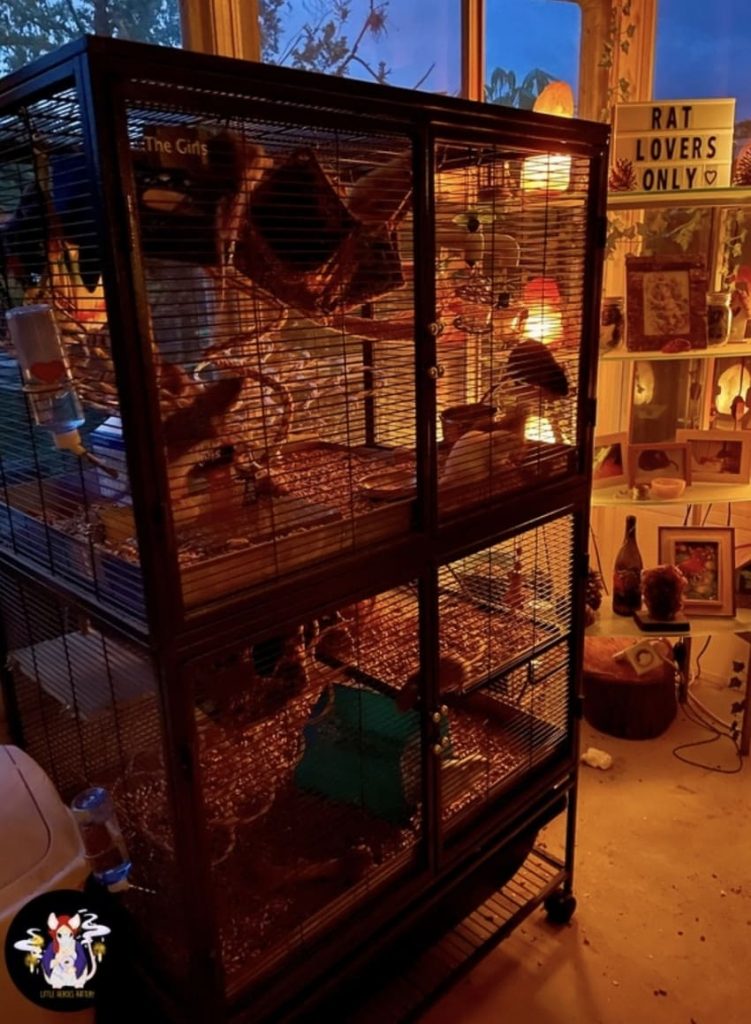
This can make it really confusing for new rat owners, and leaves a lot of rats in woefully small quarters. Rats are not like mice, and cannot be housed in glass tanks or plastic cages – they require at least 3 sides of their enclosure to allow for airflow. For this reason, metal cages make the best home for rats.
While rats really, really enjoy climbing and will spend hours investigating the variety of hanging objects you add – we must add that they are fossorial creatures. Dig boxes are a great way of managing this need they inherently have for digging. Grab a tote from the dollar store and throw in some EcoEarth. Once hydrated, all you need to do is toss in some Wheat Grass seeds and within 5 or 6 days, you will have a thick, lush, grassy dig box ready for them to tear apart. Wheat Grass, including the roots, is perfectly safe for them to eat.
Midwest Critter Nation (one level) and the Midwest Critter Nation Double Unit (two levels) are arguably the top of the line in homes for rats. With their half-inch bar spacing, even the smallest of rats can be housed in them with no problem. They are on casters, for ease of movement. You can find them on Amazon and sometimes Walmart – but searching on your local ‘for sale’ page (such as Craigslist or Nextdoor) will offer the best price if you can find someone local, who is selling theirs.
You may notice that some of ours are not the standard charcoal grey; spray painting with Rustoleum to give your cage a splash of ‘you’ is great – but make sure to leave it in a pet-free space for a minimum of 3-5 weeks after painting to air out, before putting your rats in there.
This is the cage we use exclusively for our resident rats, with a plethora of toys, hideaways, and hammocks that are ever-changing to stimulate their minds and bodies. Should you need it, you can even purchase an add-on unit to make your Midwest Critter Nation Double into a Triple!
The only downside of the Critter Nation’s is the shallow, plastic pans that come standard with it. It’s surprising to me that even after all these years, they have not upgraded the pans (I bought my first CN over a decade ago, and my most recent just 1 year ago). You can purchase replacement pans online at Bass Equipment, but be prepared for an investment nearly equal to the cost of the cage itself.
Their listed ‘Ferret Nation’ pans are an exact match for the Critter Nation, but make sure to purchase the (pricier) stainless steel (vs galvanized) unless you intend to seal it yourself. It is worth the investment! I use the 3″ deep pans, myself, and have minimal mess on the floors. They also make smaller pans custom fit for the shelves, but you can purchase plastic totes from your local home goods store for less money.
An alternate to the Bass Equipment pans would be to drop a Home Depot cement mixing tub into the bottom of your Critter Nation. This provides a good depth for offering natural digging behaviors – but is not chew-proof.
I offer my rats a wide variety of enrichment, that is changed out every week or so – to engage their brilliant little minds.
I make (and sell) my own hammocks, huts, tents, etc – and these are cleaned twice weekly (White Whale Apothecary on Etsy). I also build my own kiln-dried pine ledges and steps.
Most of the time my cages are outfitted with nets (marketed for birds), but scarf holders work just as well. It’s simply cotton or twine-wrapped metal rings – providing a good fall-safe to hang in blank space within the cage. If you crochet; you can even make your own!
I offer grapevine driftwood (marketed for fish tanks) and hang them on the sides of the cage using stainless steel zip ties, to change up their landscape. Each week I alternate the foraging toys I offer; sometimes it is foraging toys designed for birds, sometimes it’s a toilet-paper roll hanger (sold for pets by OhTheMischief on Instagram).
Additionally, each of my cages has at least two water bottles (never have less than two, in case one gets jammed) and 1-2 water bowls attached to the sides. Not only do the rats enjoy the option of drinking out of a bowl, but they also spend lots of time washing their little faces and hands in it. Throw in a handful of ice cubes before cleaning day, and they really go wild!
Say Hi to Rachel here:
- Website: https://www.littleheroesrattery.com/
- Instagram: https://www.instagram.com/little_heroes_rattery/
- Facebook: https://m.facebook.com/LittleHeroesRattery/
Madison, Rainy Zillow Rattery – Ocklawaha, FL
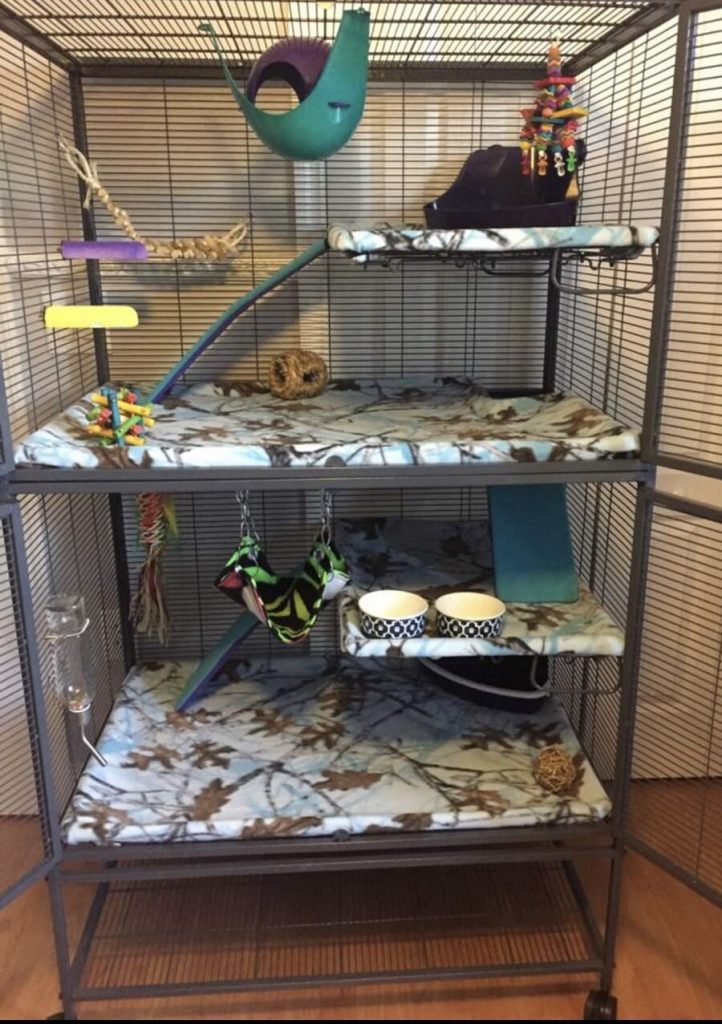
Ideally, you want the biggest cage you can afford. Rats, despite being rather small, need lots of space. I will always recommend a Critter Nation or Double Critter Nation; these are the best cages money can buy (in my opinion and experience).

Rats LOVE clutter! Ideally, you want to pack the cage full of toys, hammocks, and other accessories. The busier the cage, the better.
As for bedding, there are a few suitable choices. In my pictures below, I’ve used fleece, which can be suitable as long as it’s washed multiple times per week. Although, it’s not very absorbent and smell can accumulate pretty quickly which is why I’ve stopped using fleece recently. Paper/wood shavings are the better alternative; I recommend Aspen or Kiln-dried pine. Avoid Cedar and regular Pine.
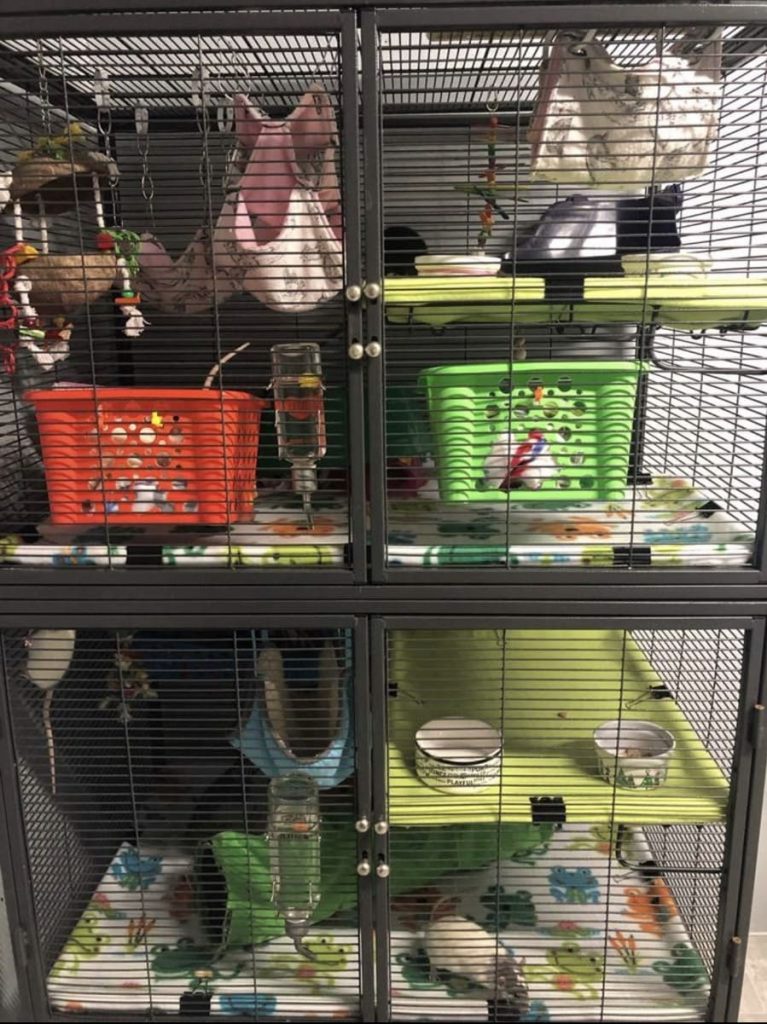
As for some “must-haves”, I LOVE Sputniks, they’re affordable and rats love being up high in their cage. I also love reusing old boxes as hides, it’s free and the rats sometimes prefer those over the more expensive huts from the store.
I also recommend glass water bottles, as there’s no way for the rats to chew them and I typically find them much easier to clean and see how much water is left.
Say Hi to Madison here:
- Website: https://rainyzillowrattery.weebly.com/
- Facebook: https://www.facebook.com/RainyZRattery/
- Instagram: https://www.instagram.com/rainy_zillow_rattery/
Shaleigh, Jones Exotics & Rattery – Bowling Green, MO
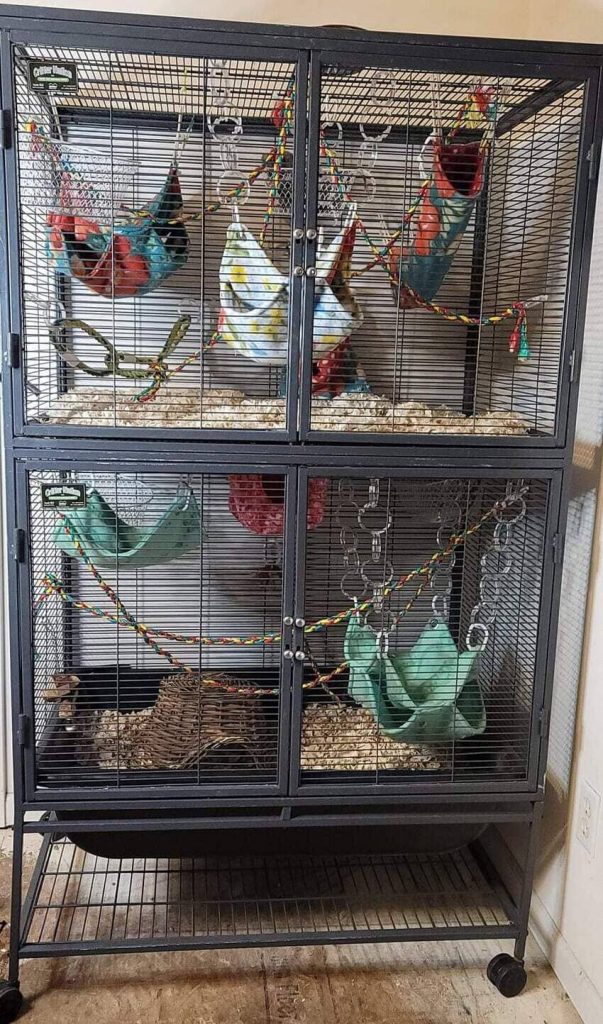
Here at Jones Exotics & Rattery, we use Double Critter Nations with cement mixing pans in the bottom. We do this for about 8″ of Aspen in the bottom for digging. We also put Aspen on the middle-level pan.
Most of our cages have made hammocks, DT plastic shower rings, DT rope, and metal baskets. My rats explore and get both levels, males and females are always separated of course!
The best tip I can give is that DIY is awesome and Dollar Tree can fill your cage with awesome stuff for cheap!
Say Hi to Shaleigh here:
Wrapping Up
We do hope that you enjoyed taking a sneak peek at these 6 breeders’ rat cage setup and that it is giving you ideas to set up your own cages. As you can see, a good rat cage setup is not that complicated – rats do like to have a large cage and a lot of clutter to snuggle into. Getting this right will ensure that your little mischief will be happy in their cute little habitat.
Related articles:

